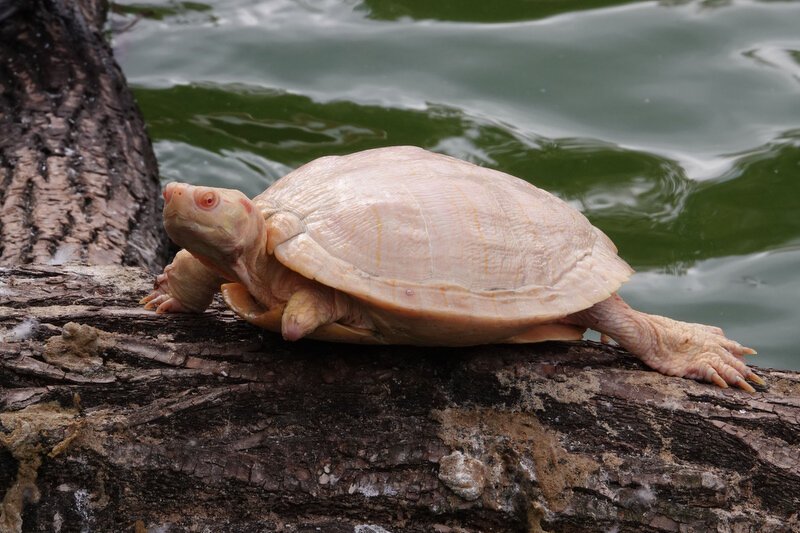Albino turtle are rare and fascinating. Their unique look makes them stand out. They have a genetic condition that affects melanin production, making them rare and captivating.
Studying albino turtles can teach us a lot about their genetics. Their rarity makes them a great subject for research. Their striking look and rare occurrence have won many hearts, sparking interest among turtle lovers and researchers.
Key Takeaways
- Albino turtles are a rare and unique species, with a genetic condition that affects the production of melanin.
- Turtle albinism is extremely rare, making these creatures a wonder to behold.
- The study of albino turtles can provide valuable insights into the genetics of turtle albinism.
- Albino turtles are a popular topic of discussion among turtle enthusiasts and researchers.
- The rarity of albino turtles makes them a valuable subject for research and conservation efforts.
- Understanding the genetic factors that contribute to turtle albinism can help conservation efforts and protect these rare turtle species.
Understanding Albino Turtles: A Unique Natural Phenomenon
Turtle albinism is a rare condition that has fascinated many. It’s caused by genetic factors that affect melanin production. Melanin is the pigment that gives skin and hair their color.
Research shows that turtle albinism comes from recessive genes. These genes are passed down from parents. It’s a rare sight in wild turtle populations, but when it happens, it’s remarkable.
What Causes Albinism in Turtles
Genetics play a big role in turtle albinism. Mutations in genes can lead to less or no melanin. This results in turtles with pale skin, eyes, and shells.
These turtles are more vulnerable to predators and environmental stress. Their lack of pigmentation makes them stand out.
Genetic Factors Behind Turtle Albinism
Studies have found several genetic factors behind turtle albinism. Mutations in the tyrosinase gene are a key factor. This gene is crucial for melanin production.
Other genes involved in melanin production also play a role. These genetic factors influence the development of albinism in turtles.
Frequency of Albinism in Wild Populations
Albinism in wild turtles is rare, affecting less than 1% of natural populations. It’s a disadvantage in the wild, making turtles more vulnerable. Despite this, it offers insights into turtle genetics and evolution.
Physical Characteristics of an Albino Turtle
The albino turtle’s appearance is truly unique and striking. They have an all-white color due to no melanin. This makes them stand out from other turtles and is a sight to see.
Some key physical traits of an albino turtle include:
- Complete lack of pigmentation, resulting in a white or pale yellow shell and skin
- Pink or red eyes, due to the visibility of the blood vessels underneath
- A higher risk of vision and hearing impairments, due to the lack of melanin
These traits are not just unique but also make them more prone to health issues. As a rare species, albino turtles need special care to thrive. Knowing their physical traits is crucial for their well-being.
Studying Albino turtle helps us appreciate and protect them. Whether you’re a turtle lover or new to them, albino turtle are truly captivating.
Common Species Found with Albinism
Albinism is rare but can be seen in many turtle species. This includes both freshwater and sea turtles. Each albino turtle is unique and interesting.
The red-eared slider and the green sea turtle are common examples. These turtles are not only rare but also help us learn about turtle biology.
Freshwater Albino Turtle Species
Freshwater turtles, like the albino red-eared slider, live in rivers and lakes. They can live up to 30 years in captivity. Their unique look makes them popular among collectors.
Sea Turtle Albino Variants
Sea turtles, like the green sea turtle, can also be albino. These rare turtles are found worldwide. Studying them helps us understand sea turtle genetics and conservation.
Most Common Albino Pet Turtle Species
The albino red-eared slider, box turtle, and African spurred tortoise are popular pets. They are small and have unique looks. But, they need special care, including the right diet and lighting.
Life Expectancy and Health Considerations
Albino turtles need special care to live long and healthy lives. Knowing their life span and health needs is key for owners. They can live from 20 to 30 years, depending on the species and care quality.
Health issues are a big worry for albino turtles. They face problems like respiratory infections, metabolic bone disease, and skin issues. Regular vet visits and a good diet can help. Also, a proper environment is crucial, with enough space, light, and temperature control.
- Providing a UVB light source to promote calcium metabolism and prevent metabolic bone disease
- Offering a balanced diet that includes a variety of vegetables, fruits, and protein sources
- Maintaining a clean and well-ventilated enclosure to prevent respiratory infections
Understanding albino turtles’ life span and health needs helps owners care for them better. With the right care, they can be amazing pets. Their unique look makes them a great conversation starter.
Special Care Requirements for Albino Turtles
Albino turtle need special care to stay healthy in captivity. It’s important to create the right environment for them. This includes UV protection, the right diet, and proper housing.
UV protection is key. Albino turtles need UVB lighting to make vitamin D3. This vitamin is vital for strong bones and calcium absorption. Without it, they can get metabolic bone disease, a common problem.
What they eat is also crucial. A balanced diet with veggies, fruits, and proteins is essential. This keeps them healthy and happy.
- Providing a high-quality commercial turtle food as the main staple
- Supplementing with dark leafy greens, such as kale and collard greens
- Offering fresh fruits, such as berries and apples
- Ensuring access to a source of calcium, such as crushed eggshells or cuttlebone
Understanding the special needs of albino turtles is key. This includes UV protection and a balanced diet. With the right care, they can be wonderful pets.
Breeding and Genetics of Albino Turtles
Albino turtle breeding is a complex process. It requires a deep understanding of albinism genetics. The genetics of albinism involve many genes, making breeding outcomes hard to predict. Albino turtles are rare in the wild, and captive breeding aims to understand and preserve them.
Several factors influence albino turtle breeding. These include choosing the right parent turtles, controlling the environment, and monitoring the offspring’s health. Breeders must also grasp the genetic principles of albinism. This affects the chance of getting albino offspring.
Some key considerations in Albino turtle breeding include:
- Genetic diversity: Keeping a diverse gene pool is key for healthy offspring.
- Selection of parents: Choosing the right parent turtles is crucial for breeding success.
- Environmental control: Managing factors like temperature, humidity, and lighting is important for offspring health.
Understanding albinism genetics and managing breeding programs can lead to healthy albino turtles. However, breeding albino turtles is complex and requires a deep genetic knowledge and a commitment to conservation.
The study of albino turtle breeding and albinism genetics offers insights into these remarkable animals’ biology and conservation.
Conservation Status and Protection Efforts
Albino turtles face many dangers like habitat loss, pollution, and hunting. This has caused their numbers to drop. Because of this, albino turtle conservation is now a big issue. Many groups are focusing on the conservation status of turtles, including albino ones, to help them.
The main aim of turtle protection is to keep their homes safe and stop their numbers from falling more. This is done through conservation initiatives like fixing habitats, studying them, and teaching people. Also, legal protection measures like laws against hunting and trading turtles are put in place.
Current Population Statistics
Recent studies show many turtle species are endangered. Some have seen their numbers drop by up to 50% in decades. This shows we need to act fast to save these animals and their homes.
Conservation Initiatives
Groups like the World Wildlife Fund (WWF) and the International Union for Conservation of Nature (IUCN) are working hard. They do things like fix habitats, study turtles, and teach people why albino turtle conservation is important.
Legal Protection Measures
Along with conservation initiatives, legal protection measures are key. Laws in many countries ban hunting and trading turtles. International agreements, like the Convention on International Trade in Endangered Species of Wild Fauna and Flora (CITES), also help protect these animals.
The Role of Albino Turtles in Research
Albino turtles have greatly helped us learn about biology and genetics. Studies on them have shown how albinism affects living things. By looking at albino turtles, scientists learn about the genes that cause albinism and its effects on these animals.
Albino turtles are important in many research areas. Here are a few examples:
- Genetic studies: They help scientists understand how melanin, the skin and hair pigment, is made.
- Biological research: Studies on them give us important info on their behavior, body functions, and how they live.
- Conservation efforts: Research on albino turtles helps protect them and their homes.
Studying albino turtles is very important for science, genetics, and saving animals. As scientists keep learning from these amazing creatures, we’ll discover more about the world of albino turtles.
By exploring the role of albino turtles in scientific research, we can deepen our understanding of the natural world and the many wonders it contains.
Conclusion: Preserving These Remarkable Creatures
The Albino turtle is a rare and fascinating creature. They face many challenges in the wild, like losing their homes and health issues. But, with the right efforts, we can save these amazing animals for future generations.
To protect albino turtles, we need to support efforts to save their homes and watch their numbers. By learning, teaching others, and speaking out, we can show how vital these animals are. Together, we can help communities protect these special places and the turtles that live there.
Our actions will decide the future of the albino turtle. By taking care of our planet, we can keep these rare wonders alive. Let’s make a promise to protect the albino turtle, one step at a time.
















Leave a Reply